Ijraset Journal For Research in Applied Science and Engineering Technology
- Home / Ijraset
- On This Page
- Abstract
- Introduction
- Conclusion
- References
- Copyright
Comparative Analysis on Inclined Column by Using Staad Pro under Lateral Loads at Different Positions
Authors: Rajeev Kumar, Neeraj Kumar Jain
DOI Link: https://doi.org/10.22214/ijraset.2022.47708
Certificate: View Certificate
Abstract
Advances in construction technology, materials, structural systems and analytical methods for analysis and design facilitated the growth of high-rise buildings. Structural design of high-rise buildings is governed by lateral loads due to wind or earthquake. Lateral load resistance of structure is provided by interior structural system or exterior structural system. Usually shear wall core, braced frame and their combination with frames are interior system, where lateral load is resisted by centrally located elements. While framed tube, braced tube structural system resists lateral loads by elements provided on periphery of structure. It is very important that the selected structural system is such that the structural elements are utilized effectively while satisfying design requirements. Recently Inclined columns structural system is adopted in tall buildings due to its structural efficiency and flexibility in architectural planning. Compared to closely spaced vertical columns in framed tube. Inclined column should be placed at the exterior surface of the building. Due to inclined columns lateral loads are resisted by axial action of the diagonal compared to bending of vertical columns in framed structure. Inclined column structures generally do not require core because lateral shear can be carried by the diagonals on the periphery of building. Analysis and design of G+9 storey building is presented. A regular floor plan of 36 m × 36 m size is considered. Staad pro software is used for modelling and analysis of structural members. All structural members are designed as per IS 456:2000 considering all load combinations. Dynamic along wind and across wind are considered for analysis and design of the structure. Load distribution in system is also studied for G+9 storey building. Similarly, analysis and design of G+9 storey vertical column structures is carried out with and without weak storey. Comparison of analysis results in terms of time period, top storey displacement and inter-storey drift will be presented in this study with or without inclined column in frame structure.
Introduction
I. INTRODUCTION
Soft storey is a common building weakness. The term soft storey explains one level of a building that is appreciably more flexible than the stories above it and the floors or the foundation under it. A soft storey can be defined on the basis of the stiffness of the adjacent floor stiffness, building can be said to be soft storey or week storey if the stiffness of that particular level is less than 70 % with respect to floor instantly above it or less than 80 % of average stiffness oft the three floors above it. Some building in which height of floor is greater in ground these type of building is knowing as Open Ground storey buildings or soft storey. The weak or soft storey commonly exists at the ground storey level, but it might be at any other storey level. Soft storey buildings have a lot of open space for example, parking garage, restaurants or floors with lots of windows. The behavior of soft storey building in an earthquake is very crucial because the soft storey building is more flexible in seismic condition, vibration is happening in the soft storey building so we provide shear wall in a soft storey building (shear wall resists the effect of an earthquake).
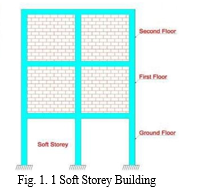
Reinforced concrete frame structures have become a common form of construction with masonry infill in urban and semi urban areas in the world. The infill framed structures are made and analyzed by the combination of a moment resisting plane frame and infill masonry walls. The infill masonry may be of brick, concrete blocks, or stones. Ideally in present time the reinforced concrete frame is filled with bricks as non-structural wall for partition of the rooms because of its advantages such as, thermal insulation, durability, cost and simple construction technique.
Nowadays, many buildings are constructed having a unique feature i.e. the ground floor remains open, which means the columns in the ground floor do not have any partition walls between them. This type of structure (Fig. 1.2) having no infill masonry walls in ground floor, but having infill masonry walls in all the upper floors, are called Open Ground Storey (OGS) Buildings. This open ground floor structure is also termed as a structure with ‘soft storey at Ground Floor’. OGS buildings are also known as open first storey building (when the floor numbering starts with one from the ground floor itself), pilots, or stilted buildings. Open first storey is nowadays unavoidable feature for the most of the urban multi-storey buildings because social and functional needs for parking, restaurant, commercial use etc. are compelling to provide an open first Storey in high rise structure. Parking has become a necessary feature for the most of urban multistoried buildings as the population is increasing at a very fast rate in urban areas leading to crisis of vehicle parking space. Hence the trend has been to use the ground floor of the building itself for parking purpose.
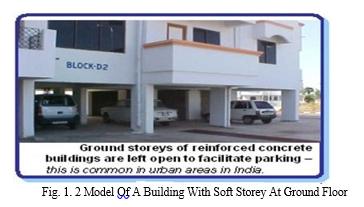
There is major advantage of this type of buildings functioning, but from the seismic performance point of view, such structures are considered to have increased vulnerability. Though multi- storied buildings with parking floor (soft storey) are vulnerable to collapse due to seismic forces, their construction is still popular. The Soft Storey buildings are usually designed as framed structures without regard to structural action of wall (masonry infill walls). In India current structural design methods, infill walls are considered as non-structural element and their strength and stiffness are ignored during analysis and design. The effect of infill panels on RC framed structures if subjected to earthquake is widely accepted and has been subjected to numerous experimental and analytical investigations over last 5 decades.
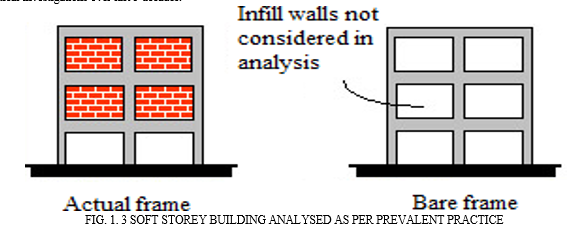
A. Behaviour Of Soft Stories In Earthquake And Wind Load
Since the presence of a soft storey which has less rigidity than other stories and if this point was not taken into consideration, it causes the construction to be affected by the earthquake because columns in this portion are forced by the earthquake more than the ones in the other parts of the building. Studies conducted suggest that walls raise the rigidity at a certain degree in the construction of buildings.
Behaviour of construction is divided into two parts, from the point where there is no soft storey, the building with equal rigidity between the stories; the displacement of the peak points at the moment of an earthquake causes the other building with a soft storey to get damaged because the construction with a soft storey cannot show the same rigidity. For example, the top point of a ten-storey building with no soft storey performs 10-unit displacement, another building with the same specification but having a soft storey at the entry floor and with no necessary precaution can show the same displacement 10-unit at this floor level. According to this outcome, a soft storey in the upper stories of the building is not so effective.
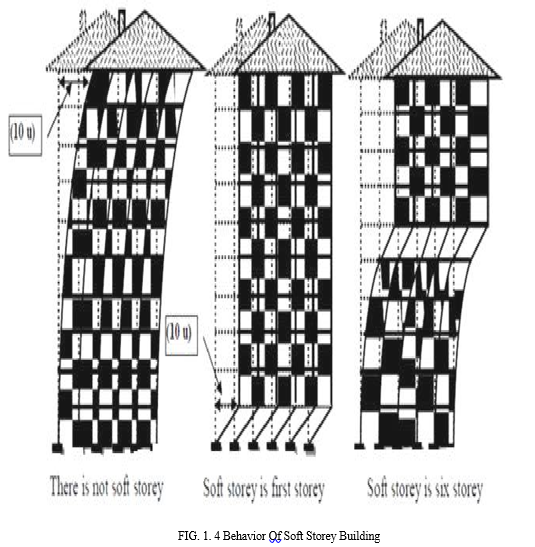
Where; “u” is the displacement
II. METHODOLOGY
The present research work deals with comparative study of behavior of soft storey building frames by considering geometrical configurations of building under earthquake loading and wind loading. The framed buildings are subjected to lateral loads and vibrations because of earthquake and wind load therefore lateral load analysis is necessary for these framed structures. The fixed base system is analyzed by employing equivalent inclined column frame structures in seismic and wind loading by means of STAAD Pro software. The responses of the same building frames are studied and evaluated the best position of soft floor which satisfies lateral loadings.
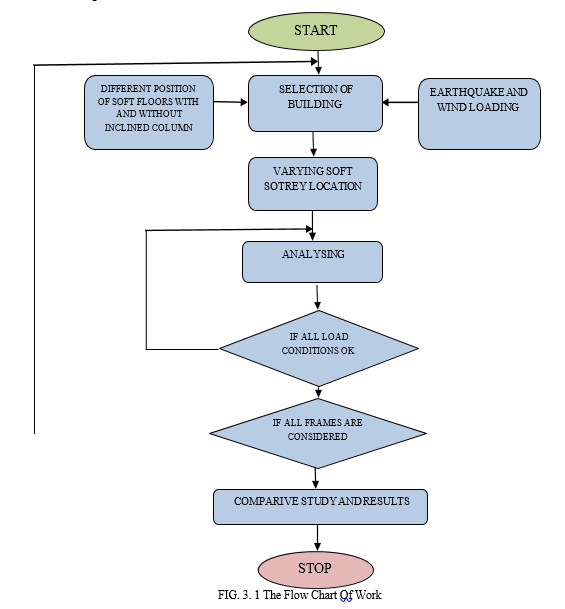
A. The Problem Formulation
- Step-1 Selection of building geometry and Seismic zone: The behavior of all the models is studied for Zone II of Seismic zones of India as per IS code 875 PART II-1987 for which zone factor (Z) is 0.10
- Step-2 Selecting geometry of 10 stories (G+9) of plan area 36m x 36m
TABLE 3. 1 TOTAL PROBLEM IN EARTHQUAKE ANALYSES
|
SR. NO. |
Cases performed |
Case No. |
Seismic zone |
Inclined column |
|
||||
|
1. |
Building without Soft Storey Without Inclined Column |
I |
1 (zone -II, Bhopal ) |
Without Inclined Column |
|
||||
|
2. |
Ground Floor Soft Storey, Without Inclined Column |
II |
1 (zone -II, Bhopal ) |
Without Inclined Column |
|
||||
|
3. |
2nd Floor Soft Storey, Without Inclined Column |
III |
1 (zone -II, Bhopal ) |
Without Inclined Column |
|
||||
|
4. |
4th Floor Soft Storey, Without Inclined Column |
IV |
1 (zone -II, Bhopal ) |
Without Inclined Column |
|
||||
|
5. |
6th Floor Soft Storey, Without Inclined Column |
V |
1 (zone -II, Bhopal ) |
Without Inclined Column |
|
||||
|
6. |
8th Floor Soft Storey, Without Inclined Column |
VI |
1 (zone -II, Bhopal ) |
Without Inclined Column |
|
||||
|
7. |
Top Floor Soft Storey, Without Inclined Column |
VII |
1 (zone -II, Bhopal ) |
Without Inclined Column |
|
||||
|
8. |
Ground Floor Soft Storey, With Inclined Column in Horizontally Placed floor |
VIII |
1 (zone -II, Bhopal ) |
With Inclined Column |
|
||||
|
9. |
2nd Floor Soft Storey, With Inclined Column in Horizontally Placed floor |
IX |
1 (zone -II, Bhopal ) |
With Inclined Column |
|
||||
|
10. |
4th Floor Soft Storey, With Inclined Column in Horizontally Placed floor |
X |
1 (zone -II, Bhopal ) |
With Inclined Column |
|
||||
|
11. |
6th Floor Soft Storey, With Inclined Column in Horizontally Placed floor |
XI |
1 (zone -II, Bhopal ) |
With Inclined Column |
|
||||
|
12. |
8th Floor Soft Storey, With Inclined Column in Horizontally Placed floor |
XII |
1 (zone -II, Bhopal ) |
With Inclined Column |
|
||||
|
13. |
Top Floor Soft Storey, With Inclined Column in Horizontally Placed floor |
XIII |
1 (zone -II, Bhopal ) |
With Inclined Column |
|
||||
|
14. |
Ground Floor Soft Storey, With Inclined Column at Corners of building |
XIV |
1 (zone -II, Bhopal ) |
With Inclined Column |
|
||||
|
15. |
2nd Floor Soft Storey, With Inclined Column at Corners of building |
XV |
1 (zone -II, Bhopal ) |
With Inclined Column |
|
||||
|
16. |
4th Floor Soft Storey, With Inclined Column at Corners of building |
XVI |
1 (zone -II, Bhopal ) |
With Inclined Column |
|
||||
|
17. |
6th Floor Soft Storey, With Inclined Column at Corners of building |
XVII |
1 (zone -II, Bhopal ) |
With Inclined Column |
|||||
|
18. |
8th Floor Soft Storey, With Inclined Column at Corners of building |
XVIII |
1 (zone -II, Bhopal ) |
With Inclined Column |
|||||
|
19. |
Top Floor Soft Storey, With Inclined Column at Corners of building |
XIX |
1 (zone -II, Bhopal ) |
With Inclined Column |
|||||
|
20. |
Ground Floor Soft Storey, With Inclined Column at Centre of building |
XX |
1 (zone -II, Bhopal ) |
With Inclined Column |
|||||
|
21. |
2nd Floor Soft Storey, With Inclined Column at Centre of building |
XXI |
1 (zone -II, Bhopal ) |
With Inclined Column |
|||||
|
22. |
4th Floor Soft Storey, With Inclined Column at Centre of building |
XXII |
1 (zone -II, Bhopal ) |
With Inclined Column |
|||||
|
23. |
6th Floor Soft Storey, With Inclined Column at Centre of building |
XXIII |
1 (zone -II, Bhopal ) |
With Inclined Column |
|||||
|
24. |
8th Floor Soft Storey, With Inclined Column at Centre of building |
XXIV |
1 (zone -II, Bhopal ) |
With Inclined Column |
|||||
|
25. |
Top Floor Soft Storey, With Inclined Column at Centre of building |
XXV |
1 (zone -II, Bhopal ) |
With Inclined Column |
|||||
TABLE 3. 2 TOTAL PROBLEM IN WIND ANALYSES
|
SR. NO. |
Cases performed |
Case No. |
Wind Zone |
Inclined column |
|
1. |
Building without Soft Storey Without Inclined Column |
I |
1 (Vb= 39m/s, Bhopal ) |
Without Inclined Column |
|
2. |
Ground Floor Soft Storey, Without Inclined Column |
II |
1 (Vb= 39m/s, Bhopal ) |
Without Inclined Column |
|
3. |
2nd Floor Soft Storey, Without Inclined Column |
III |
1 (Vb= 39m/s, Bhopal ) |
Without Inclined Column |
|
4. |
4nd Floor Soft Storey, Without Inclined Column |
IV |
1 (Vb= 39m/s, Bhopal ) |
Without Inclined Column |
|
5. |
Ground Floor Soft Storey, With Inclined Column |
V |
1 (Vb= 39m/s, Bhopal ) |
With Inclined Column |
|
6. |
2nd Floor Soft Storey, With Inclined Column |
VI |
1 (Vb= 39m/s, Bhopal ) |
With Inclined Column |
|
7. |
4th Floor Soft Storey, With Inclined Column |
VII |
1 (Vb= 39m/s, Bhopal ) |
With Inclined Column |
So, total 7 problems are analyzed in Staad
3. Step-3 Modelling of soft stories floor wise.
4. Step-4 Selection of Equivalent inclined column (200 mm x 200 mm) and above I to VII Cases considered.
5. Step-5 Formation of load combination
Types of Primary Loads and Load Combinations: The structural systems are subjected to Primary Load and Load Combinations Cases as per I.S. 875 (Part I, Part II, Part III and Part V). and IS-1893 Part I-2016 framed are given in Table 3.3
TABLE 3. 3 NUMBER OF LOAD CASES IN EARTHQUAKE AND WIND LOAD CALCULATIONS
|
Load case no. |
Load Case Details |
|
1. |
E.Q. IN X_DIR. |
|
2. |
E.Q. IN Z_DIR. |
|
3. |
DEAD LOAD |
|
4. |
LIVE LOAD |
|
5. |
W.L. IN X_DIR. |
|
6. |
W.L. IN Z_DIR. |
|
7. |
1.5 (DL + LL) |
|
8. |
1.5 (DL + EQ_X) |
|
9. |
1.5 (DL – EQ_X) |
|
10. |
1.5 (DL + EQ_Z) |
|
11. |
1.5 (DL – EQ_Z) |
|
12. |
1.2 (DL + LL + EQ_X) |
|
13. |
1.2 (DL + LL – EQ_X) |
|
14. |
1.2 (DL + LL + EQ_Z) |
|
15. |
1.2 (DL + LL – EQ_Z) |
|
16. |
1.5 (DL + W.L. _X) |
|
17. |
1.5 (DL – W.L. _X) |
|
18. |
1.5 (DL + W.L. _Z) |
|
19. |
1.5 (DL – W.L. _Z) |
|
20. |
1.2 (DL + LL + W.L._X) |
|
21. |
1.2 (DL + LL – W.L. _X) |
|
22. |
1.2 (DL + LL + W.L. _Z) |
|
23. |
1.2 (DL + LL – W.L. _Z) |
|
24. |
0.9 DL + EQ_X |
|
25. |
0.9 DL – EQ_X |
|
26. |
0.9 DL + EQ_Z |
|
27. |
0.9 DL – EQ_Z |
6. Step-6 Modelling of building frames in STAAD.Pro software
7. Step-7 Analysis of building frames with and without soft stories cases from given seismic zone and each load combination.
8. Step-8 Comparative study with graph and tables by maximum moments, displacement, stories displacement, drift, axial force and shear force.
III. MATERIAL AND GEOMETRICAL PROPERTIES
Following properties of material have been considered in the modeling - Density of RCC: 25 KN/m3
Density of Masonry: 20 KN/m3 (Assumed) Poisson’s ratio: 0.17
Young's modulus of concrete: 5000√ƒ????????
The foundation depth is considered at 1.5 m below ground level and the normal floor height is 3 m and soft floor height is considered as 4.2m. 3x3m grid and 12x12m plan is considered with G+5 stories in building is considered.
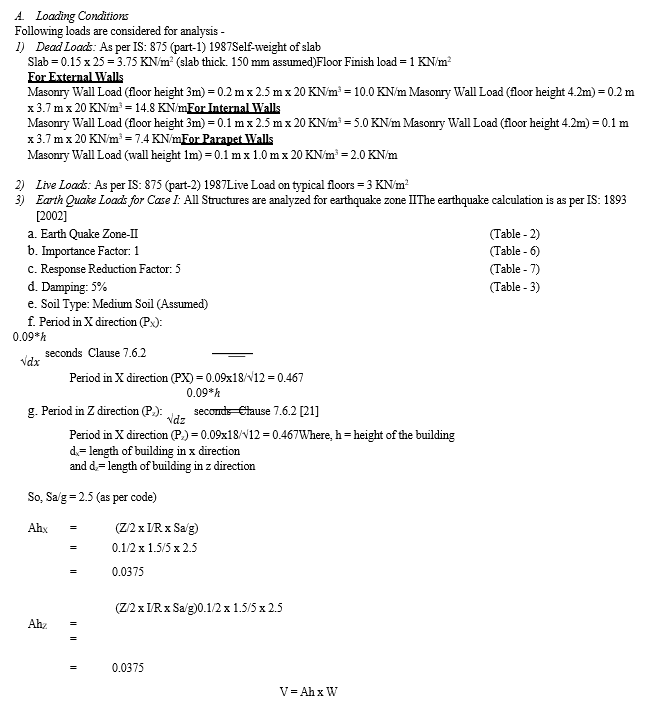
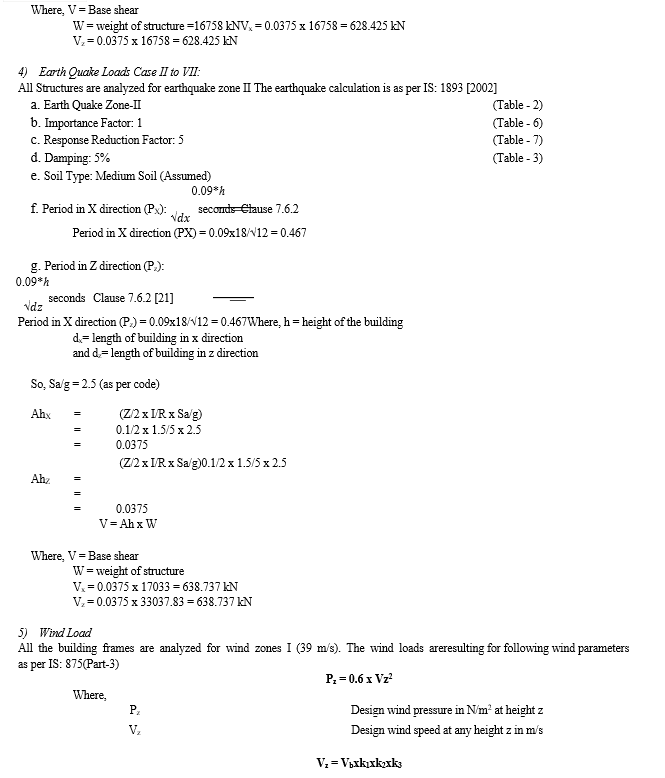
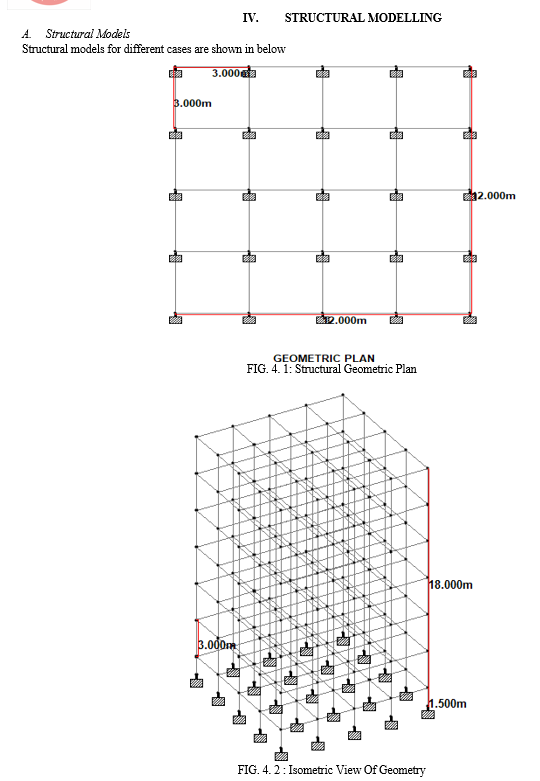
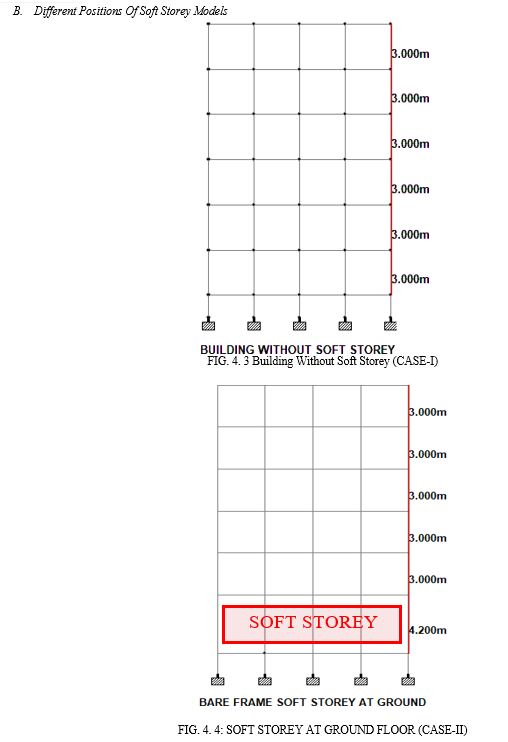
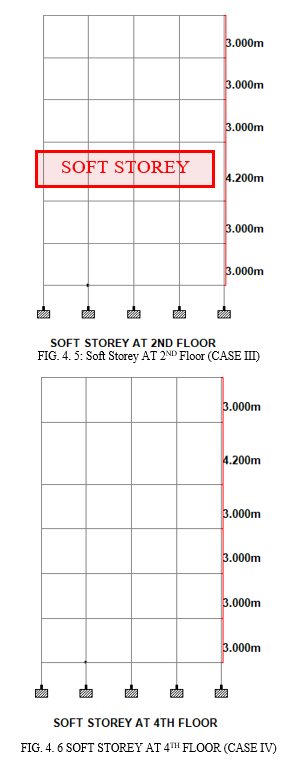
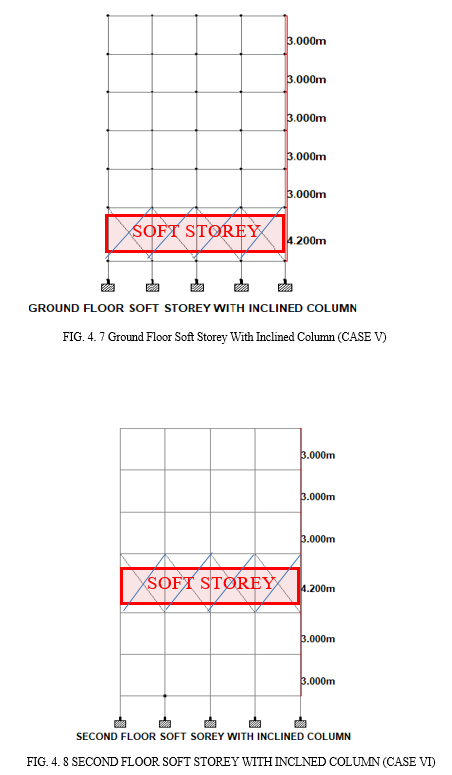
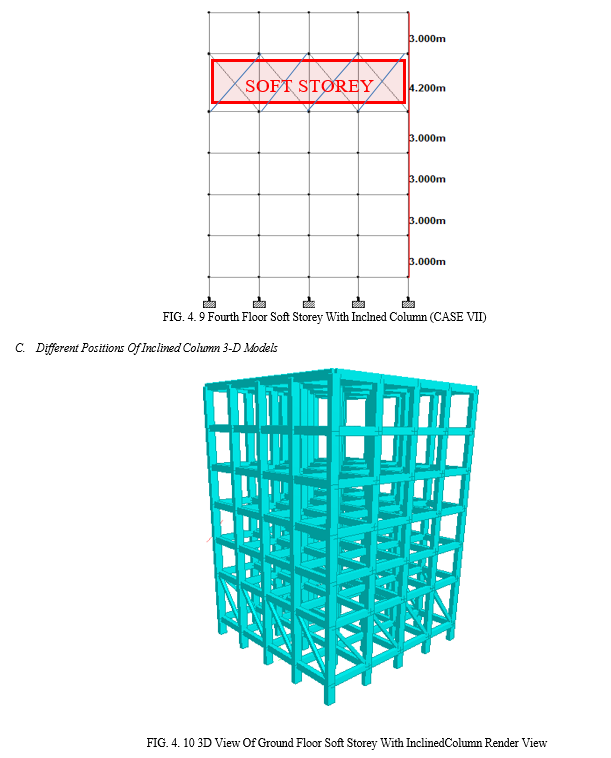
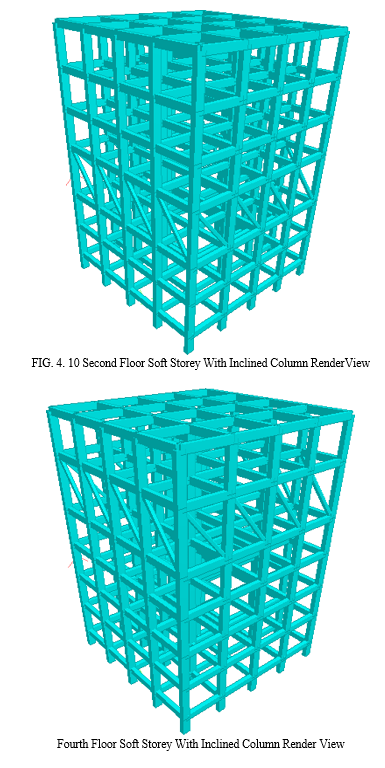
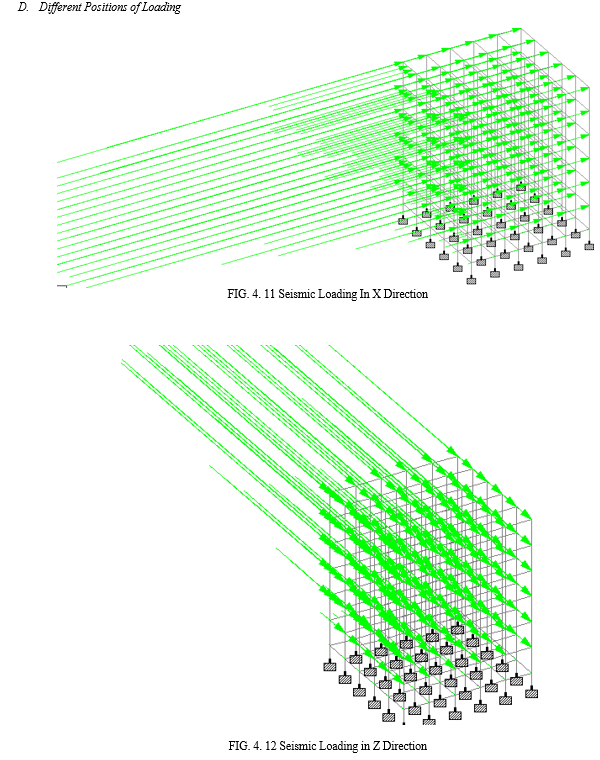
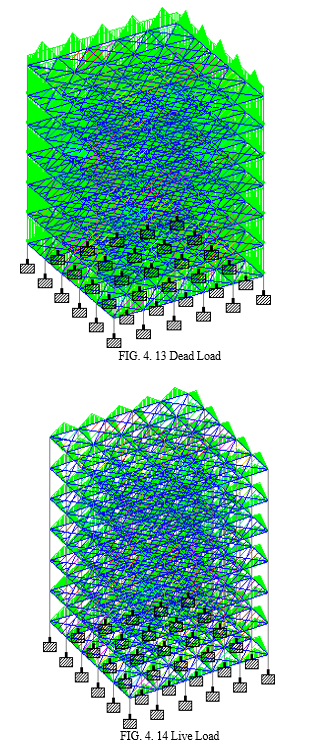
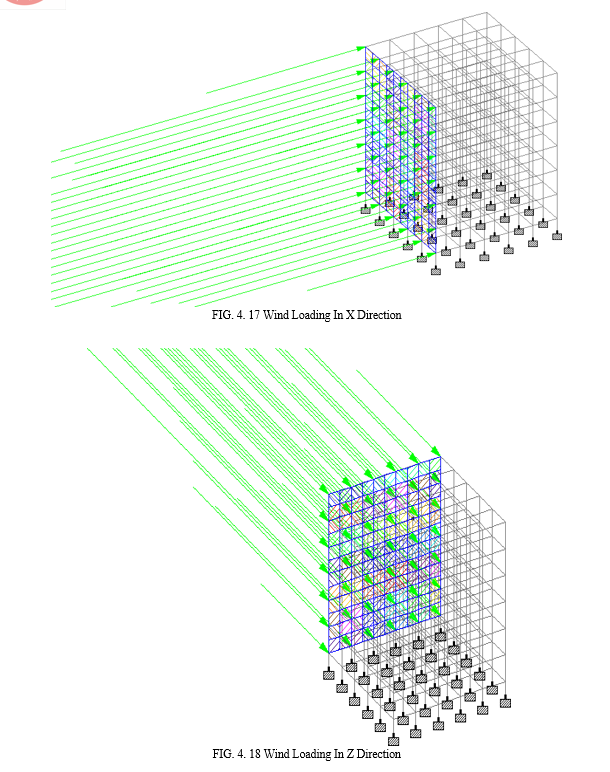
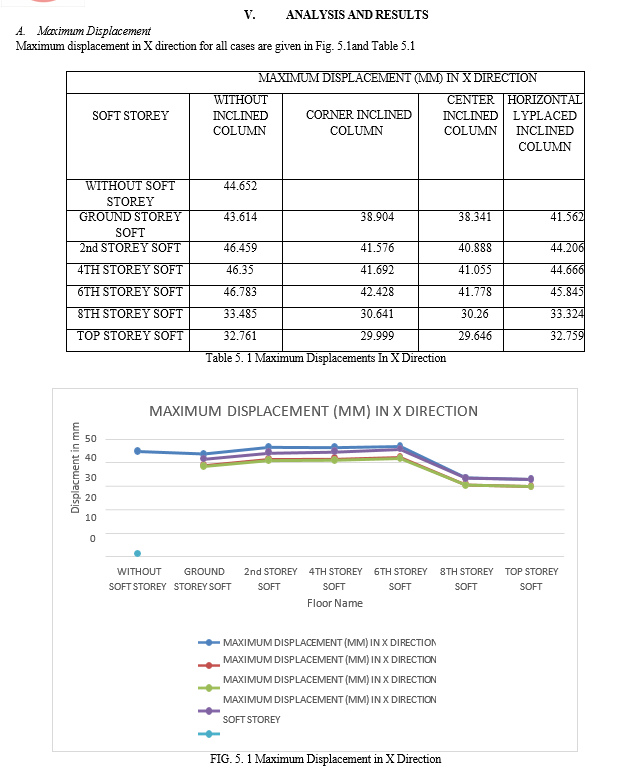
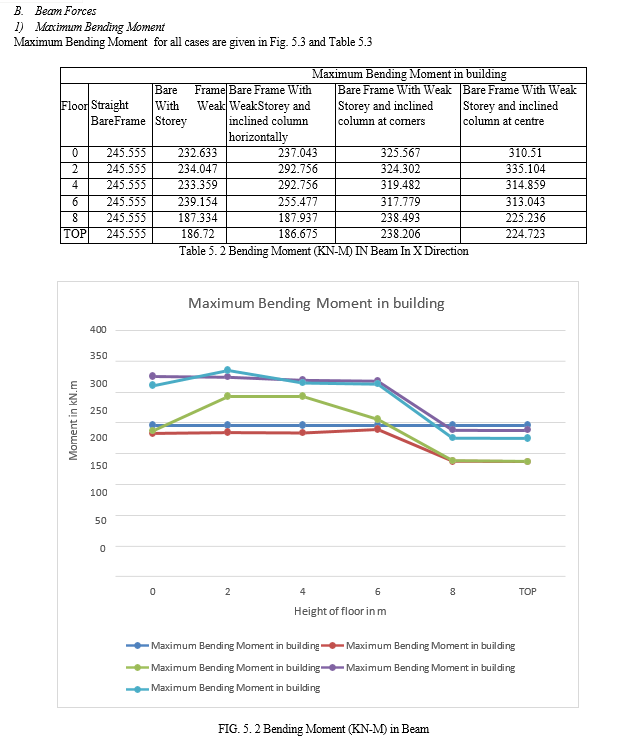
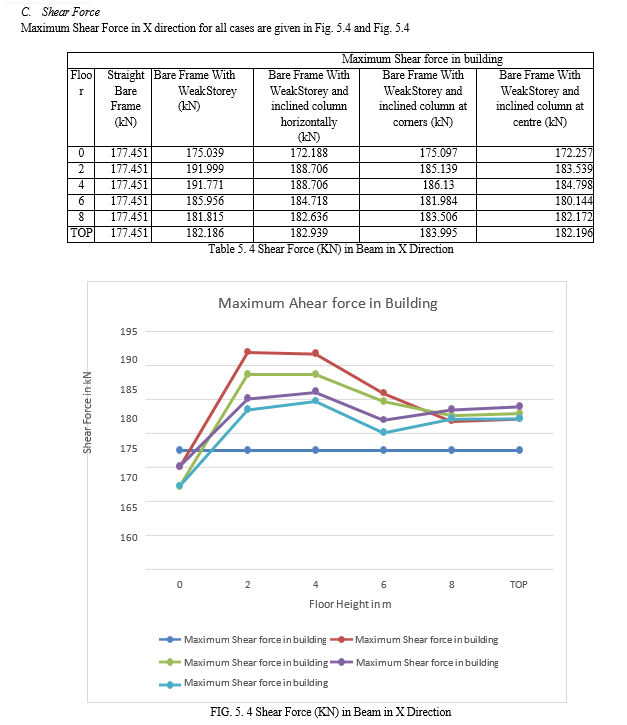
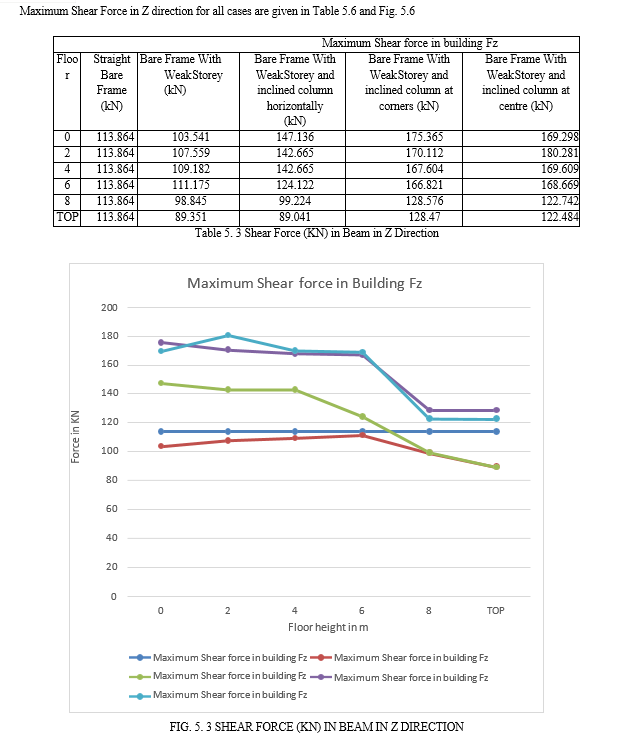
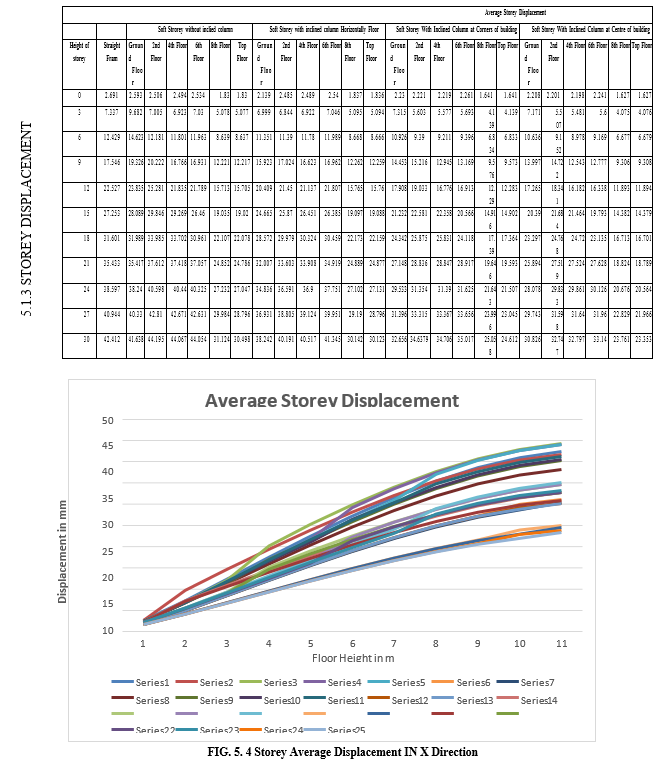
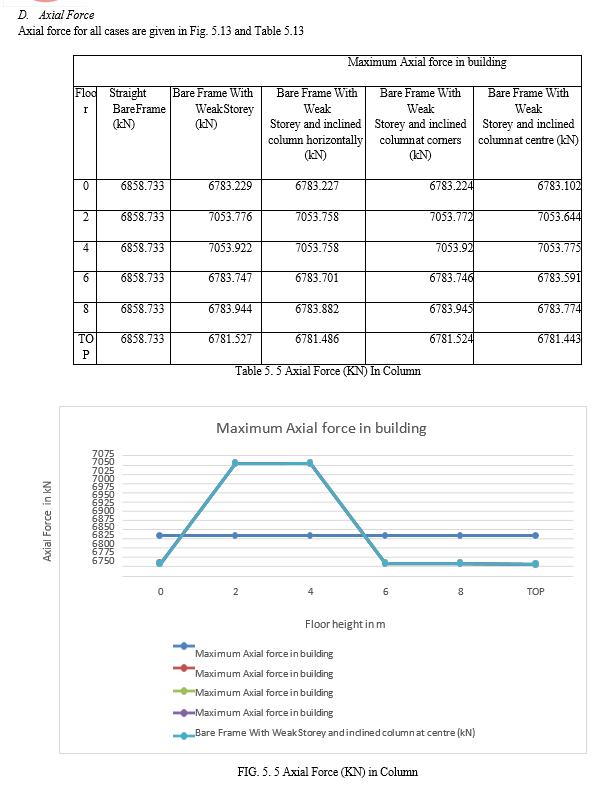
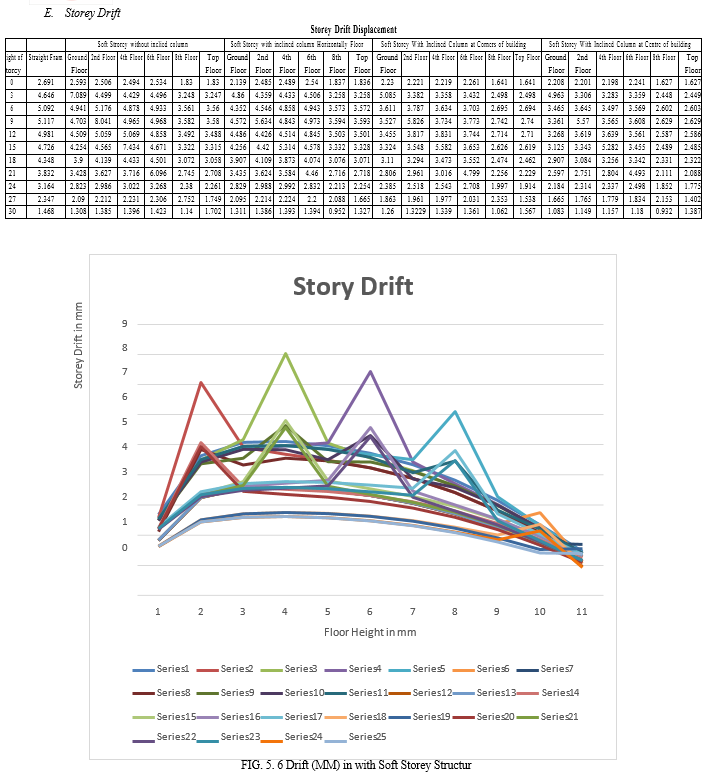
VI. RESULT & DISCUSSION
Following is the salient result discussion of this study-
A. Bending Moment
- Considering maximum moment, it is observed that soft storey at ground floor without inclined column is critical in X direction and critical at second floor in Z direction when soft storey is stiffed with inclined column. Equivalent inclined column shows poor performance when 2nd storey is soft floor. So it can be concluded that soft storey at middle floor must be avoided.
- It is seen from the bending moment results that structure is most stable in non-soft floor conditions, but if it is necessary to provide soft floor in high rise building structure must be stiffened at soft floor with the help of inclined column and position of soft floor must be at higher level.
B. Shear Force
- Considering shear force, it is observed that soft storey at ground floor without inclined column is critical in X direction and critical at second floor in Z direction when soft storey is stiffed with inclined column. Equivalent inclined column shows poor performance when 2nd storey is soft floor. So it can be concluded that soft storey at middle floor must be avoided.
- It is seen from the shear force results that structure is most stable in non-soft floor conditions, but if it is necessary to provide soft floor in high rise building structure must be stiffened at soft floor with the help of inclined column and position of soft floor must be at higher level.???????
C. Maximum Displacement
Considering maximum displacement in worst loading combination, maximum displacement is observed in soft storey at second floor without inclined column and minimum when building is without soft storey. But if it is necessary to provide soft storey in the building then it should be placed at higher level of building with inclined column at soft floor.
???????D. Axial Force
It is observed that maximum axial force is generated due to worst load combination of earthquake loading or horizontal wind loading case at fourth floor soft storey without inclined column and minimum axial force generation at fourth floor soft storey with inclined column.
E. Storey Displacement
- Storey displacement is maximum when we place soft storey at higher level of building as compared to the bottom floors.
- Result of analysis shows that storey displacement is maximum at case where soft storey at fourth floor without inclined column and it is minimum in a building when building without soft storey and without inclined column.
???????F. Drift
Drift is observed maximum in building where soft storey at higher level without inclined column, but if we provide inclined column at same level this means if soft storey is provided at higher level bottom storey of structure will have less drift.
G. Overall Summary
Providing Soft storey at higher with equivalent inclined column produces better results against lateral loading of earthquake and wind loads in form of minimum forces results of Moments, Shear Force, Maximum Displacement, Axial Forces and Drift. Only Storey displacement results shows that soft storey at bottom floors is effective.
Conclusion
A. Conclusion 1) From above results it is observed that equivalent inclined column strengthens the structure from the soft storey. It is clear that CASE-III (building frame with soft storey at ground floor and without equivalent inclined column) is most critical and CASE-1 (building without soft storey and without inclined column) is best and efficient one, while CASE-VII (soft storey at higher floor with inclined column) is second best. 2) Means providing equivalent inclined column at soft floor will reduces moment, shear force, displacement, storey displacement and drift. The analyses of high rise building with different floor conditions studied under the effect of seismic and wind load condition. 3) So, it is concluded that Equivalent inclined column not only strengthen structure but also provide better stiffness and it is found that soft floor at higher level is more stable in building frame structure which also justify the purpose of the work. 4) Purpose of preparing this report is to find the soft storey location(level) in a high rise building, so has to have minimum effect of external forces on the structural stability. 5) This study will provide the results against various locations of soft floor with or without placing inclined columns in the building frame. Results are based on the behavior of building against the lateral forces (Earth quake and wind Forces) as analyzed by software Staad pro. B. Future Scope Of The Study 1) In this study RCC framed structures have been considered. The study can be extended to steel frame structures. 2) In this study fixed supports have been provided. The study can be extended considering different support conditions. 3) This study considered only one seismic zone viz. zone-II. In further study more seismic zones can be included. 4) This study deals with plane terrain condition and in further study sloping ground can be considered. 5) In this study thermal effects have not been considered in further study the same can be considered.
References
[1] Arturo Tena-Colunga, Héctor Correa-Arizmendi, José Luis Luna-Arroyo, Gonzalo Gatica-Avilés (2008); Seismic behavior of code-designed medium rise special moment- resisting frame RC buildings in weak soils of Mexico city ; Engineering Structures, Volume 30, Issue 12, Pages 3681-3707 [2] Asiz A. ,Chui Y.H. ,Doudak G. ,Ni C. ,Mohammad M. (2011) ; Contribution of Plasterboard Finishes to Structural Performance of Multi-storey Light Wood Frame Buildings ; Procedia Engineering, Volume 14,Pages 1572-1581 [3] Asthana A.K. , Datta T.K.(1990) ; A simplified response spectrum method for random vibration analysis of flexible base ; Engineering Structures, Volume 12, Issue 3,Pages 185-194 [4] Adachi Kazuhiko, Kitamura Yoshitsugu, Iwatsubo Takuzo (2004) ; ntegrated design of piezoelectric damping system for flexible structure ; Applied Acoustics, Volume 65, Issue 3, Pages 293-310 [5] Awkar J.C. , Lui E.M. (1999) ; Seismic analysis and response of multistory semi-rigid frames ; Engineering Structures, Volume 21, Issue 5,Pages 425-441 [6] Balendra T. ,Lee S.L. (1987) ; Seismic response of a submerged spherical structure supported on a flexible foundation ; Engineering Structures, Volume 9, Issue 1,Pages 39- 44 [7] Chen Y.Q., Constantinou M.C. (October 1990) ;Use of Teflon sliders in a modification of the concept of weak first storey; Engineering Structures, Volume 12, Issue 4,Pages 243- 253 [8] Chen Y.Q., Constantinou M.C. (1992) ; Use of Teflon sliders in a modification of the concept of weak first storey ; Construction and Building Materials, Volume 6, Issue 2, Pages 97-105 [9] Chopra, A. K., Dynamics of Structures (1995): Theory and Applications to Earthquake Engineering, Prentice-Hall. Inc., Englewood Cliffs, New Jersey [10] Chung Lap-Loi, Chen Yung-Tsang, Sun Chi-Hsiang ,Lien Kuan-Hua , Wu Lai-Yun (2012) ; Applicability investigation of code-defined procedures on seismic performance assessment of typical school buildings in Taiwan ; Engineering Structures, Volume 36,Pages 147-159 [11] Datta T. K., Seismic Analysis of Structures, John Wiley & Sons (Asia) Pte Ltd., Singapore,2010.
Copyright
Copyright © 2022 Rajeev Kumar, Neeraj Kumar Jain. This is an open access article distributed under the Creative Commons Attribution License, which permits unrestricted use, distribution, and reproduction in any medium, provided the original work is properly cited.

Download Paper
Paper Id : IJRASET47708
Publish Date : 2022-11-26
ISSN : 2321-9653
Publisher Name : IJRASET
DOI Link : Click Here
 Submit Paper Online
Submit Paper Online

